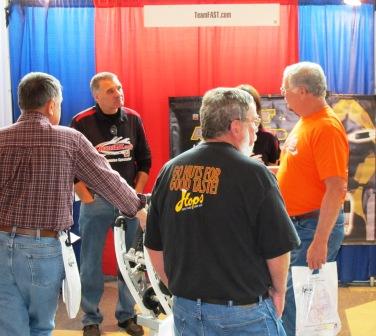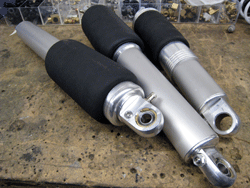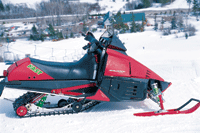There are many who relegated FAST and its premium snowmobile brand, Blade, to exist only in the annals of snowmobile lore. For every model year since the first ones hit the snow 10 years ago, however, there is a Blade snowmobile — including 2009 models. With its Blade, the company is far more than an asterisk in the chronology of snowmobile manufacturing.
It was the spring of 1998 when Snow Goer magazine got an exclusive look at sketches and engineering drawings of a snowmobile that Eveleth, Minnesota-based FAST was bringing to market. Then-editor John Prusak and I met with David Karpik — the chief behind the machine — and we knew we were looking at a snowmobile like no other.
I remember looking at the blueprints of a sophisticated long-travel front suspension, a boxed frame and an engine that was mounted backward. At the time I knew I was looking at a combination of unconventional ideas, the sum of which formed a snowmobile that was technologically advanced and expensive. But little did I know the impact FAST would have on the rest of the industry until years later, because it took that long for the rest of the industry to respond to the company’s genius.
Ahead Of Its Time
A decade later, I sat across from Karpik, the owner of Blade Powersports. In addition to building Blades, FAST has clients for whom they perform CNC milling. FAST is a suspension development firm for clients in the snow and offroad industries, and it sells its M-10 and AirWave suspensions, too.
“We introduced the M-10 in 1993 and only figured that to be short-lived,” Karpik said. “We really thought the Big Four [manufacturers] were going to run us over and eat our lunch within a year and a half to two years.”
With the pressure of losing its bread and butter product, Karpik, along with his brothers Gerard and Randy, believed they had to work on something else. They had ideas and felt the snowmobile industry would benefit from them.
“We visited with every manufacturer in the mid-1990s offering our services and our product and we really didn’t get anywhere with any of them,” Karpik said. “This is why we focused on building an entire vehicle. We weren’t going to be able to supply an industry with our technology — whether they were unwilling to accept it, or didn’t believe in it or it cost too much — whatever the reason. We didn’t get the ideas sold so we needed our own vehicle to get it done.
“When we first started the Blade, we put the key things on the board: ‘What do we want to achieve?’” he said. “We had already introduced long-travel in the front and rear with our M-10, and we had a number of long-travel front suspensions. That wasn’t new to the industry. What we wanted to do was build a really agile snowmobile — an easy-to-ride snowmobile.”
The result was the Blade, and it first appeared publicly at the Haydays snowmobile grass drags in Columbus, Minnesota, in September 1998. With its full-perimeter, boxed frame and engine mounted low and rearward, the sled was a rolling catalog of patents. The sled encapsulated the spirit of inventors: they envisioned a better product and built it. The concepts in the Blade inspired the most recent evolution of snowmobile chassis design.

In the mid-1990s, manufacturers filled their press kits with information about how they lowered the center of gravity to improve stability. Wider, deeper bulkheads with engine mounts fastened high on the case allowed engines to sit lower. Ski-Doo abandoned its Rotax rotary-valve engines, building instead case-reed engines that could sit low in the chassis. Manufacturers were putting the engine weight as low as they could, but sleds were getting long. The engine weight was getting well in front of the driver.
“All that predicated our thinking, ‘If we turn this engine around, what happens?’ Immediately, some really nice things happened,” Karpik said.
“Bringing some of that weight back to the driver was our goal with mass centralization. It doesn’t sound like a big idea now,” Karpik said. “You didn’t hear about mass centralization at all until the first round of the REV years later.”
The Blade In Present Day
The industry today is based on concepts FAST developed in the middle 1990s, Karpik said. Every modern snowmobile uses the principles of mass centralization.
“What we introduced in 1998 had some good compliments,” Karpik said. “I remember one of the engineers from one of the big four said, ‘That darn FAST. All they’re here for is to make more work for the rest of us.’ It was a compliment.”
Compliments turn into copied designs in many cases. Like many small inventors, large companies “borrow” the technology or work cleverly around patents. Karpik said they know some of their patents are being used, and the users are aware of the infringement. But large corporations can easily outspend a court battle against a company like FAST, making patent lawsuits difficult to fight.
“The entire industry has benefited from what we did,” Karpik said. He readily admits the four manufacturers are making some great product now and said in many ways they’ve caught up to the performance of the premium, exotic Blade. But where they haven’t come close, he said, is coming up with a full-perimeter frame.
“I don’t think there’s anyone [at FAST] who says, ‘Well, they caught up to us. Where do we go from here?’” he said. “We’re still better. It’s the only snowmobile out there with a full frame. Everybody else might say they have pyramidal frames and that, but it all comes back to hooking it up to a lesser-qualified part. Generally that’s the tunnel. The tunnel for us is just a fender. You can put 10,000 miles on a Blade chassis and that thing is still tight.”
Blades have progressed with the times. For the last two model years, Blades have housed Polaris’ Liberty 700 CFI engine. They come with the award-winning AirWave rear suspension and more creature comforts such as electric start, which many Blade customers prefer. Customers are also the reason Karpik upgraded to Polaris’ Liberty 800 engine for the 2009 model year.

Trial And Error
“Anyone can build one of anything,” Karpik said. “But replicating it time after time after time and building everything else that needs to go with it — it’s monumental. We did not, by any means, succeed in many areas. But the area where we did succeed was performance.”
During its peak production year, FAST built 240 Blades. Karpik admitted the company didn’t spend enough money in marketing to build any serious momentum, trying instead to rest on the laurels of performance. “That’s an area that I oversaw,” he said. “It’s something I failed to get done. Unfortunately we learned it at the expense of our company. We just started to get into high times and move toward shifting gears, and — bam! The bottom fell out. It hit us harder than the rest of the industry. There was 9-11, another year of no snow, the stock market crash — we went from 50 employees down to six people in three months. What you see today is not that same company anymore.”
Success
Though the school of hard knocks delivered some harsh lessons, there are 10 years worth of Blades on the snow. And there is a next-generation Blade drawn up, and could be in snowmobiling’s future if the right manufacturing partners align with FAST.
Though much of the company is different in a pure economic sense, the same entrepreneurial, inventive spirit that brought the M-10, the game-changing Blade and the recent AirWave suspension to market drives FAST today. The Karpiks have accomplished a deserved place in snowmobile history, with more modern influence than any other manufacturer. The original goal of the Blade — deliver innovative technology and ideas that the snowmobile industry deserved — was met.
“We built a brand,” Karpik said. “That’s our legacy. We built the world’s premier brand of snowmobiles and nobody can take that away from us.”



